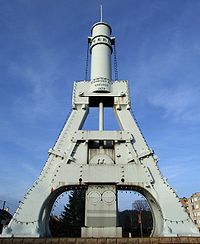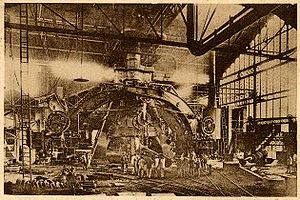
Creusot steam hammer
Encyclopedia

Steam hammer
A steam hammer is a power-driven hammer used to shape forgings. It consists of a hammer-like piston located within a cylinder. The hammer is raised by the pressure of steam injected into the lower part of a cylinder and falls down with a force by removing the steam. Usually, the hammer is made to...
built in 1877 by Schneider and Co.
Schneider Electric
Schneider Electric is a French global company. It was founded in 1836 by two brothers, Eugène and Adolphe Schneider.In the first part of the 20th century, Schneider et Cie associated itself with Westinghouse Systems, a major international electrical group at the time. The group began manufacturing...
in the French
France
The French Republic , The French Republic , The French Republic , (commonly known as France , is a unitary semi-presidential republic in Western Europe with several overseas territories and islands located on other continents and in the Indian, Pacific, and Atlantic oceans. Metropolitan France...
industrial town of Le Creusot
Le Creusot
Le Creusot is a commune in the Saône-et-Loire department in the region of Bourgogne in eastern France.The inhabitants are known as Creusotins. Formerly a mining town, its economy is now dominated by metallurgical companies such as ArcelorMittal, Schneider Electric, and Alstom.Since the 1990s, the...
. With the ability to deliver a blow of up to 100 tons, the Creusot hammer was the most powerful in the world until 1891, when the Bethlehem Iron Company of the United States
United States
The United States of America is a federal constitutional republic comprising fifty states and a federal district...
purchased patent rights from Schneider and built a steam hammer of almost identical design but capable of delivering a 125 ton blow.
The Creusot hammer still exists, although it is no longer operational, and is a tourist attraction in the town of Le Creusot where it was built. With few remaining rivals, the hammer today is once again the largest of its kind in the world.
The Creusot steam hammer was named a Historic Mechanical Engineering Landmark by the American Society of Mechanical Engineers
American Society of Mechanical Engineers
The American Society of Mechanical Engineers is a professional body, specifically an engineering society, focused on mechanical engineering....
in 1981.
Origins
In 1836, Joseph-Eugene Schneider and his brother Adolphe purchased a derelict ironworks in Burgundy, near the town of Le Creusot, and founded Schneider Brothers & Co. (later renamed Schneider & Co.). Two years later the company produced the first steam locomotiveSteam locomotive
A steam locomotive is a railway locomotive that produces its power through a steam engine. These locomotives are fueled by burning some combustible material, usually coal, wood or oil, to produce steam in a boiler, which drives the steam engine...
to be built in France. Eugene Schneider along with the company's chief engineer, François Bourdon, developed the world's first true steam hammer at the Schneider works in 1841. Schneider and Co. went on to build 110 steam hammers of all sizes between 1843 and 1867, 26 of which were employed by the firm itself. As the jobs grew more demanding, the hammers grew correspondingly larger, and the Schneiders eventually saw a need for a hammer of colossal proportions.
The Creusot steam hammer was completed in 1877, and with its ability to deliver a blow of up to 100 tons, eclipsed the previous record set by the German
Germany
Germany , officially the Federal Republic of Germany , is a federal parliamentary republic in Europe. The country consists of 16 states while the capital and largest city is Berlin. Germany covers an area of 357,021 km2 and has a largely temperate seasonal climate...
firm Krupp
Krupp
The Krupp family , a prominent 400-year-old German dynasty from Essen, have become famous for their steel production and for their manufacture of ammunition and armaments. The family business, known as Friedrich Krupp AG Hoesch-Krupp, was the largest company in Europe at the beginning of the 20th...
, whose steam hammer "Fritz" with its 50 ton blow had held the title as the world's most powerful steam hammer since 1861. In celebration of this technological achievement, a full scale wooden replica of the Creusot hammer was built and displayed at the Paris Universal Exposition
Exposition Universelle (1878)
The third Paris World's Fair, called an Exposition Universelle in French, was held from 1 May through to 10 November 1878. It celebrated the recovery of France after the 1870 Franco-Prussian War.-Construction:...
of 1878.
Description

Anvil
An anvil is a basic tool, a block with a hard surface on which another object is struck. The inertia of the anvil allows the energy of the striking tool to be transferred to the work piece. In most cases the anvil is used as a forging tool...
, the legs, the steam cylinder
Pneumatic cylinder
Pneumatic cylinders are mechanical devices which utilize the power of compressed gas to produce a force in a reciprocating linear motion....
and its valves and linkages, and finally, the active mass itself — the piston
Piston
A piston is a component of reciprocating engines, reciprocating pumps, gas compressors and pneumatic cylinders, among other similar mechanisms. It is the moving component that is contained by a cylinder and is made gas-tight by piston rings. In an engine, its purpose is to transfer force from...
, piston rod
Piston rod
In a piston engine, a piston rod joins a piston to a connecting rod.Many internal combustion engines, and in particular all current automobile engines, do not have true piston rods, and the term piston rod is often used as a synonym for connecting rod in the context of these engines.All engines...
, hammerhead and die
Die (manufacturing)
A die is a specialized tool used in manufacturing industries to cut or shape material using a press. Like molds, dies are generally customized to the item they are used to create...
.
The anvil weighed a massive 750 ton
Ton
The ton is a unit of measure. It has a long history and has acquired a number of meanings and uses over the years. It is used principally as a unit of weight, and as a unit of volume. It can also be used as a measure of energy, for truck classification, or as a colloquial term.It is derived from...
s, and in order to support the weight and the hammer blows, the machine's foundations were built of solid masonry resting on bedrock 11 meters below the soil. A one-metre thick bed of oak
Oak
An oak is a tree or shrub in the genus Quercus , of which about 600 species exist. "Oak" may also appear in the names of species in related genera, notably Lithocarpus...
timber topped the masonry foundation and provided the immediate floor for the giant anvil.
The four legs are hollow cast, rectangular in cross-section and were originally bolted to plates embedded in the masonry. The legs are 10.25 meters high and connected to one another at the top in a rigid A-frame design by a 30-ton "table", that in its working life both guided the hammerhead and distributed the shock of its blows. One leg supports the operator's platform from which the machine was controlled.
The steam cylinder itself is 6 meters high and has an inside diameter of 1.9 meters. Steam pressure averaging 5 kg/cm² or 71 psi drove the cylinder upwards through two balanced single-acting slide valves, after which the force of gravity would allow the hammer to fall and deliver a blow.
The piston had a maximum travel of 5 meters and the piston rod was 35 centimeters in diameter. The hammerhead or tup was interchangeable, with a number of differently shaped dies which may account for the hammer's reported variable force of between 75 and 100 tons. The actual force delivered may have been in the order of 3.3 million foot-pounds (or 500,000 kilogram-metres).
Four separate furnace
Furnace
A furnace is a device used for heating. The name derives from Latin fornax, oven.In American English and Canadian English, the term furnace on its own is generally used to describe household heating systems based on a central furnace , and sometimes as a synonym for kiln, a device used in the...
s provided steam power to four adjacent swan-necked cranes
Steam crane
A steam crane is a crane powered by a steam engine. It may be fixed or mobile and, if mobile, it may run on rail tracks, caterpillar tracks, road wheels, or be mounted on a barge...
, which were used for manipulating the massive 120-ton iron and steel ingots delivered to the hammer for forging. Six Bessemer converters supplied the steel for the ingots, which were transported on a railway line built expressly for the purpose through the works.
Demonstrations
In its heyday, the hammer would sometimes give public demonstrations of its accuracy. It could be used to cork a bottle, crack a nut without damaging the contents, or tap a watch glass without breaking it. With such demonstrations, steam hammers for a time became symbols of industrial precision.Redundancy
Steam hammers were eventually made redundant with the introduction of hydraulicHydraulic press
A hydraulic is a machine using a hydraulic cylinder to generate a compressive force. It uses the hydraulic equivalenta mechanical lever, and was also known as a Bramah press after the inventor, Joseph Bramah, of England. He invented and was issued a patent on this press in 1795...
and mechanical steel presses, which could apply force more evenly and create better quality product. The giant American hammer built by Bethlehem Iron which had superseded the Creusot hammer in 1891 was demolished by 1902, but the Creusot hammer itself had a much longer service life, soldiering on for 54 years until its final retirement in 1930.
Tourist attraction
In 1969 the Creusot hammer was dismantled and reassembled in Le Creusot town square. Although it has no source of steam in its current location and is therefore non-functional, it still serves as a tourist attraction and a reminder of a bygone era of technological achievement.Footnotes
External links
- Photo of the Creusot hammer in Le Creusot town square, Cycling Revealed website.

